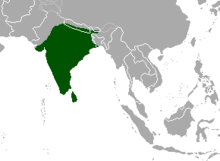Axis deer
| Chital | |
|---|---|
 |
|
| Chital from Assam State Zoo cum Botanical Garden | |
| Scientific classification | |
| Kingdom: | Animalia |
| Phylum: | Chordata |
| Class: | Mammalia |
| Order: | Artiodactyla |
| Family: | Cervidae |
| Subfamily: | Cervinae |
| Genus: |
Axis C. H. Smith, 1827 |
| Species: | A. axis |
| Binomial name | |
|
Axis axis (Erxleben, 1777) |
|
 |
|
| Chital native range | |
The chital (pronounced /t͡ʃɪtl̩/) or cheetal (Axis axis), also known as spotted deer or axis deer, is a deer found in the Indian subcontinent. The species was first described by German naturalist Johann Christian Polycarp Erxleben in 1777. A moderate-sized deer, male chital reach nearly 90 centimetres (35 in) and females 70 centimetres (28 in) at the shoulder. While males weigh 30–75 kilograms (66–165 lb), the lighter females weigh 25–45 kilograms (55–99 lb). The species is sexually dimorphic: males are larger than females, and antlers are present only on males. The upper parts are golden to rufous, completely covered in white spots. The abdomen, rump, throat, insides of legs, ears and tail are all white. The antlers, three-pronged, are nearly 1 metre (3.3 ft) long.
The scientific name of the chital is Axis axis. "Axis" has several possible origins: the Greek axōn, the Lithuanian ašis, or the Sanskrit akṣaḥ. The vernacular name chital (pronounced /ˈchētəl/) is derived from the Hindi cītal or from the Sanskrit citrala, both of which mean "variegated", in reference to the spotted coat of the deer. Another possible origin is from the Sanskrit citra which means "bright" or "spotted". The name of the cheetah has a similar origin. Other names for the chital are cheetal, cheetul, Indian spotted deer or simply the spotted deer, and axis deer.
...
Wikipedia

